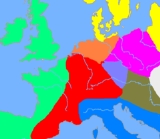
Urnfield culture
Encyclopedia
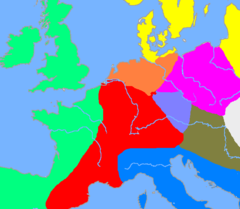
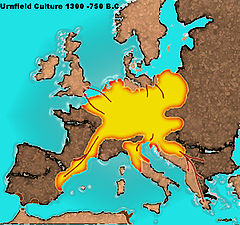
Bronze Age
The Bronze Age is a period characterized by the use of copper and its alloy bronze as the chief hard materials in the manufacture of some implements and weapons. Chronologically, it stands between the Stone Age and Iron Age...
culture of central Europe
Europe
Europe is, by convention, one of the world's seven continents. Comprising the westernmost peninsula of Eurasia, Europe is generally 'divided' from Asia to its east by the watershed divides of the Ural and Caucasus Mountains, the Ural River, the Caspian and Black Seas, and the waterways connecting...
. The name comes from the custom of cremating
Cremation
Cremation is the process of reducing bodies to basic chemical compounds such as gasses and bone fragments. This is accomplished through high-temperature burning, vaporization and oxidation....
the dead and placing their ashes in urn
Urn
An urn is a vase, ordinarily covered, that usually has a narrowed neck above a footed pedestal. "Knife urns" placed on pedestals flanking a dining-room sideboard were an English innovation for high-style dining rooms of the late 1760s...
s which were then buried in fields. The Urnfield culture followed the Tumulus culture
Tumulus culture
The Tumulus culture dominated Central Europe during the Middle Bronze Age .It was the descendant of the Unetice culture. Its heartland the area previously occupied by the Unetice culture besides Bavaria and Württemberg...
and was succeeded by the Hallstatt culture
Hallstatt culture
The Hallstatt culture was the predominant Central European culture from the 8th to 6th centuries BC , developing out of the Urnfield culture of the 12th century BC and followed in much of Central Europe by the La Tène culture.By the 6th century BC, the Hallstatt culture extended for some...
.
Chronology
It is believed that in some areas, such as in southwestern Germany, it was in existence around 1200 BC (beginning of Ha A), but the Bronze D RiegseeRiegsee
Riegsee is a municipality in the district of Garmisch-Partenkirchen, in Bavaria, Germany....
-phase already contains cremations. As the transition from the middle Bronze Age
Bronze Age
The Bronze Age is a period characterized by the use of copper and its alloy bronze as the chief hard materials in the manufacture of some implements and weapons. Chronologically, it stands between the Stone Age and Iron Age...
to the Urnfield culture was gradual, there are questions regarding how to define it.
The Urnfield culture covers the phases Hallstatt A and B (Ha A and B) in Paul Reinecke's chronological system, not to be confused with the Hallstatt culture
Hallstatt culture
The Hallstatt culture was the predominant Central European culture from the 8th to 6th centuries BC , developing out of the Urnfield culture of the 12th century BC and followed in much of Central Europe by the La Tène culture.By the 6th century BC, the Hallstatt culture extended for some...
(Ha C and D) of the following Iron Age
Iron Age
The Iron Age is the archaeological period generally occurring after the Bronze Age, marked by the prevalent use of iron. The early period of the age is characterized by the widespread use of iron or steel. The adoption of such material coincided with other changes in society, including differing...
. This corresponds to the Phases Montelius III-IV of the Northern Bronze Age. Whether Reinecke's Bronze D is included varies according to author and region.
The Urnfield culture is divided into the following sub-phases (based on Müller-Karpe sen.):
| date BC | |
|---|---|
| BzD | 1300–1200 |
| Ha A1 | 1200–1100 |
| Ha A2 | 1100–1000 |
| HaB1 | 1000–800 |
| HaB2 | 900–800 |
| Ha B3 | 800–750 |
The existence of the Ha B3-phase is contested, as the material consists of female burials only. As can be seen by the arbitrary 100-year ranges, the dating of the phases is highly schematic. The phases are based on typological changes, which means that they do not have to be strictly contemporaneous across the whole distribution. All in all, more radiocarbon- and dendro-dates would be highly desirable.
Origin
The Urnfield culture grew from the preceding tumulus cultureTumulus culture
The Tumulus culture dominated Central Europe during the Middle Bronze Age .It was the descendant of the Unetice culture. Its heartland the area previously occupied by the Unetice culture besides Bavaria and Württemberg...
. The transition is gradual, in the pottery
Pottery
Pottery is the material from which the potteryware is made, of which major types include earthenware, stoneware and porcelain. The place where such wares are made is also called a pottery . Pottery also refers to the art or craft of the potter or the manufacture of pottery...
as well as the burial rites. In some parts of Germany, cremation and inhumation existed simultaneously (facies Wölfersheim). Some graves contain a combination of tumulus-culture pottery and Urnfield sword
Sword
A sword is a bladed weapon used primarily for cutting or thrusting. The precise definition of the term varies with the historical epoch or the geographical region under consideration...
s (Kressborn, Bodenseekreis) or tumulus culture incised pottery together with early Urnfield types (Mengen). In the North, the Urnfield culture was only adopted in the HaA2 period.
16 pins deposited in a swamp in Ellmoosen (Kr. Bad Aibling, Germany) cover the whole chronological range from Bronze B to the early Urnfield period (Ha A). This demonstrates a considerable ritual continuity. In the Loire
Loire (river)
The Loire is the longest river in France. With a length of , it drains an area of , which represents more than a fifth of France's land area. It is the 170th longest river in the world...
, Seine
Seine
The Seine is a -long river and an important commercial waterway within the Paris Basin in the north of France. It rises at Saint-Seine near Dijon in northeastern France in the Langres plateau, flowing through Paris and into the English Channel at Le Havre . It is navigable by ocean-going vessels...
and Rhône
Rhône River
The Rhone is one of the major rivers of Europe, rising in Switzerland and running from there through southeastern France. At Arles, near its mouth on the Mediterranean Sea, the river divides into two branches, known as the Great Rhone and the Little Rhone...
, certain fords contain deposits from the late Neolithic onwards up to the Urnfield period.
The origins of the cremation rite is commonly believed to be the Balkans
Balkans
The Balkans is a geopolitical and cultural region of southeastern Europe...
, where it was widespread in the eastern part of the Tumulus culture. Some cremations begin to be found in the Proto-Lusatian and Trzciniec culture
Trzciniec culture
The Trzciniec culture was an ancient tradition that subsisted in central Europe. Archeologists speculate its existence to have been between the years 1700 and 1200 BC....
.
Distribution and local groups
The Urnfield culture was located in an area stretching from western Hungary to eastern France, from the AlpsAlps
The Alps is one of the great mountain range systems of Europe, stretching from Austria and Slovenia in the east through Italy, Switzerland, Liechtenstein and Germany to France in the west....
to near the North Sea.
Local groups, mainly differentiated by pottery, include:
- Knovíz-culture in western and Northern BohemiaBohemiaBohemia is a historical region in central Europe, occupying the western two-thirds of the traditional Czech Lands. It is located in the contemporary Czech Republic with its capital in Prague...
, southern Thuringia and North-eastern Bavaria - Milavce-culture in southeastern Bohemia
- Velatice-Baierdorf in MoraviaMoraviaMoravia is a historical region in Central Europe in the east of the Czech Republic, and one of the former Czech lands, together with Bohemia and Silesia. It takes its name from the Morava River which rises in the northwest of the region...
and AustriaAustriaAustria , officially the Republic of Austria , is a landlocked country of roughly 8.4 million people in Central Europe. It is bordered by the Czech Republic and Germany to the north, Slovakia and Hungary to the east, Slovenia and Italy to the south, and Switzerland and Liechtenstein to the... - Čaka in western SlovakiaSlovakiaThe Slovak Republic is a landlocked state in Central Europe. It has a population of over five million and an area of about . Slovakia is bordered by the Czech Republic and Austria to the west, Poland to the north, Ukraine to the east and Hungary to the south...
- Northeast-Bavarian Group, divided into a lower BavariaBavariaBavaria, formally the Free State of Bavaria is a state of Germany, located in the southeast of Germany. With an area of , it is the largest state by area, forming almost 20% of the total land area of Germany...
n and an upper Palatinate group - Unstrut group in ThuringiaThuringiaThe Free State of Thuringia is a state of Germany, located in the central part of the country.It has an area of and 2.29 million inhabitants, making it the sixth smallest by area and the fifth smallest by population of Germany's sixteen states....
, a mixture between Knovíz-culture and the South-German Urnfield culture.
South-German Urnfield culture
- Lower-Main-Swabian group in southern Hesse and Baden-Württemberg, including the MarburgMarburgMarburg is a city in the state of Hesse, Germany, on the River Lahn. It is the main town of the Marburg-Biedenkopf district and its population, as of March 2010, was 79,911.- Founding and early history :...
er, HanauHanauHanau is a town in the Main-Kinzig-Kreis, in Hesse, Germany. It is located 25 km east of Frankfurt am Main. Its station is a major railway junction.- Geography :...
er, lower Main and FriedbergerFriedbergerFriedberger may refer to:* Friedberger Ach, a small river in Bavaria, Germany* Friedberger Baggersee, a lake in Swabia, Bavaria, Germany- Family name :...
facies. - Rhenish-Swiss group in Rhineland-Palatinate, SwitzerlandSwitzerlandSwitzerland name of one of the Swiss cantons. ; ; ; or ), in its full name the Swiss Confederation , is a federal republic consisting of 26 cantons, with Bern as the seat of the federal authorities. The country is situated in Western Europe,Or Central Europe depending on the definition....
and eastern FranceFranceThe French Republic , The French Republic , The French Republic , (commonly known as France , is a unitary semi-presidential republic in Western Europe with several overseas territories and islands located on other continents and in the Indian, Pacific, and Atlantic oceans. Metropolitan France...
, (abbreviated RSFO in French).
Lower-Rhine urnfields
- Lower Hessian Group
- North-Netherlands-Westphalian group
- Northwest-Group in the Dutch Delta region.
Sometimes the distribution of artifacts belonging to these groups shows sharp and consistent borders, which might indicate some political structures, like tribes. Metalwork is commonly of a much more widespread distribution than pottery and does not conform to these borders. It may have been produced at specialised workshops catering for the elite of a large area.
Important French cemeteries include Châtenay
Châtenay
Châtenay or Chatenay is the name or part of the name of several communes in France:* Châtenay, in the Ain département* Châtenay, in the Eure-et-Loir département* Châtenay, in the Isère département...
and Lingolsheim
Lingolsheim
Lingolsheim is a commune in the Bas-Rhin department in Alsace in north-eastern France. The town lies near Strasbourg-Geography:Lingolsheim is situated southwest of Strasbourg, being a principal suburb between the city centre and Strasbourg Airport. Road access to he city is provided by departmental...
(Alsace). An unusual earthworks was constructed at Goloring
Goloring
The Goloring is an ancient earthworks monument located near Koblenz, Germany. It was created in the Bronze Age era, which dates back to the Urnfield culture . During this time a widespread solar cult is believed to have existed in Central Europe....
near Koblenz
Koblenz
Koblenz is a German city situated on both banks of the Rhine at its confluence with the Moselle, where the Deutsches Eck and its monument are situated.As Koblenz was one of the military posts established by Drusus about 8 BC, the...
in Germany
Germany
Germany , officially the Federal Republic of Germany , is a federal parliamentary republic in Europe. The country consists of 16 states while the capital and largest city is Berlin. Germany covers an area of 357,021 km2 and has a largely temperate seasonal climate...
.
Related cultures
Lusatian culture
The Lusatian culture existed in the later Bronze Age and early Iron Age in most of today's Poland, parts of Czech Republic and Slovakia, parts of eastern Germany and parts of Ukraine...
forms part of the urnfield tradition, but continues into the Iron Age
Iron Age
The Iron Age is the archaeological period generally occurring after the Bronze Age, marked by the prevalent use of iron. The early period of the age is characterized by the widespread use of iron or steel. The adoption of such material coincided with other changes in society, including differing...
without a notable break.
The Piliny culture in northern Hungary
Hungary
Hungary , officially the Republic of Hungary , is a landlocked country in Central Europe. It is situated in the Carpathian Basin and is bordered by Slovakia to the north, Ukraine and Romania to the east, Serbia and Croatia to the south, Slovenia to the southwest and Austria to the west. The...
and Slovakia
Slovakia
The Slovak Republic is a landlocked state in Central Europe. It has a population of over five million and an area of about . Slovakia is bordered by the Czech Republic and Austria to the west, Poland to the north, Ukraine to the east and Hungary to the south...
grew from the tumulus culture, but used urn burials as well. The pottery shows strong links to the Gáva-culture, but in the later phases, a strong influence of the Lusatian culture
Lusatian culture
The Lusatian culture existed in the later Bronze Age and early Iron Age in most of today's Poland, parts of Czech Republic and Slovakia, parts of eastern Germany and parts of Ukraine...
is found. In Italy
Italy
Italy , officially the Italian Republic languages]] under the European Charter for Regional or Minority Languages. In each of these, Italy's official name is as follows:;;;;;;;;), is a unitary parliamentary republic in South-Central Europe. To the north it borders France, Switzerland, Austria and...
the late bronze age-early iron age proto-Villanovan and Villanovan culture
Villanovan culture
The Villanovan culture was the earliest Iron Age culture of central and northern Italy, abruptly following the Bronze Age Terramare culture and giving way in the 7th century BC to an increasingly orientalizing culture influenced by Greek traders, which was followed without a severe break by the...
show similarities with the urnfields of central Europe . Urnfields are found in the French Languedoc
Languedoc
Languedoc is a former province of France, now continued in the modern-day régions of Languedoc-Roussillon and Midi-Pyrénées in the south of France, and whose capital city was Toulouse, now in Midi-Pyrénées. It had an area of approximately 42,700 km² .-Geographical Extent:The traditional...
and Catalonia
Catalonia
Catalonia is an autonomous community in northeastern Spain, with the official status of a "nationality" of Spain. Catalonia comprises four provinces: Barcelona, Girona, Lleida, and Tarragona. Its capital and largest city is Barcelona. Catalonia covers an area of 32,114 km² and has an...
from the 9th to 8th centuries. The change in burial custom was most probably influenced by developments further east.
Ethnic ascription
As there are no written sources, the languages spoken by the bearers of the Urnfield culture are unknown. Some scholars consider them to be the ancestors of the Celts. Urnfield material is found in some of the areas where later people were to be called "Keltoi" or "Galatai" by classical authors. As we do not know how processes of ethnogenesisEthnogenesis
Ethnogenesis is the process by which a group of human beings comes to be understood or to understand themselves as ethnically distinct from the wider social landscape from which their grouping emerges...
work or how long they last, and whether a common material culture is always associated with social and political unity, this is highly contested.
Migrations
The numerous hoards of the Urnfield culture and the existence of fortified settlements (hill fortHill fort
A hill fort is a type of earthworks used as a fortified refuge or defended settlement, located to exploit a rise in elevation for defensive advantage. They are typically European and of the Bronze and Iron Ages. Some were used in the post-Roman period...
s) were taken as evidence for widespread warfare and upheaval by some scholars.
Written sources describe several collapses and upheavals in the Eastern Mediterranean, Anatolia and the Levant around the time
Bronze Age collapse
The Bronze Age collapse is a transition in southwestern Asia and the Eastern Mediterranean from the Late Bronze Age to the Early Iron Age that some historians believe was violent, sudden and culturally disruptive...
of the Urnfield origins:
- End of the Mycenean culture with a conventional date of ca. 1200 BC
- Destruction of TroyTroyTroy was a city, both factual and legendary, located in northwest Anatolia in what is now Turkey, southeast of the Dardanelles and beside Mount Ida...
VI ca. 1200 BC - Battles of Ramses III against the Sea PeoplesSea PeoplesThe Sea Peoples were a confederacy of seafaring raiders of the second millennium BC who sailed into the eastern Mediterranean, caused political unrest, and attempted to enter or control Egyptian territory during the late 19th dynasty and especially during year 8 of Ramesses III of the 20th Dynasty...
, 1195–1190 BC - End of the HittiteHittitesThe Hittites were a Bronze Age people of Anatolia.They established a kingdom centered at Hattusa in north-central Anatolia c. the 18th century BC. The Hittite empire reached its height c...
empire 1180 BC - Settlement of the PhilistinesPhilistinesPhilistines , Pleshet or Peleset, were a people who occupied the southern coast of Canaan at the beginning of the Iron Age . According to the Bible, they ruled the five city-states of Gaza, Askelon, Ashdod, Ekron and Gath, from the Wadi Gaza in the south to the Yarqon River in the north, but with...
in Palestine ca. 1170 BC
Some scholars, among them Wolfgang Kimmig and P. Bosch-Gimpera have postulated a Europe-wide wave of migrations. The so-called Dorian invasion
Dorian invasion
The Dorian invasion is a concept devised by historians of Ancient Greece to explain the replacement of pre-classical dialects and traditions in southern Greece by the ones that prevailed in Classical Greece...
of Greece was placed in this context as well (although more recent evidence suggests that the Dorians moved in 1100 BC into a post Mycenaean vacuum, rather than precipitating the collapse). Better methods of dating have shown that these events are not as closely connected as once thought.
More recently Robert Drews, after having reviewed and dismissed the migration hypothesis, has suggested that the observed cultural associations may be in fact partly explained as the result of a new kind of warfare based upon the slashing Niue sword, and with bands of infantry replacing chariots in warfare. Drews suggests that the political instability that this brought to centralised states based upon maryannu
Maryannu
Maryannu is an ancient word for the caste of chariot-mounted hereditary warrior nobility which dominated many of the societies of the Middle East during the Bronze Age.The term is attested in the Amarna letters written by Haapi...
chariotry caused the breakdown of these polities.
Settlements
The number of settlements increased sharply in comparison with the preceding tumulus culture. Unfortunately, few have been comprehensively excavated.Fortified settlements, often on hilltops or in river-bends, are typical for the urnfield culture. They are heavily fortified with dry-stone or wooden ramparts. Excavations of open settlements are rare, but they show that large 3-4 aisled houses built with wooden posts and wall of wattle and daub
Wattle and daub
Wattle and daub is a composite building material used for making walls, in which a woven lattice of wooden strips called wattle is daubed with a sticky material usually made of some combination of wet soil, clay, sand, animal dung and straw...
were common. Pit dwellings are known as well, they might have served as cellars.
Open settlements
The houses were one or two-aisled. Some were quite small, 4.5 m x 5 m at the Runde Berg (Urach, Germany), 5-8m long in Künzig (Bavaria, Germany), others up to 20 m long. They were built with wooden posts and walls of wattle and daub.At the Velatice-settlement of Lovčičky (Moravia, CR) 44 houses have been excavated.
Large bell shaped storage pits are known from the Knovíz-culture. The settlement of Radonice
Radonice
Radonice is a village situated in north-western Czech Republic. It lies perhaps 10 km south of Kadaň, 322 metres above the sea level. Its name is derived from a personal name Radoň – the village of Radoň's people...
(Louny) contained over 100 pits. They were most probably used to store grain and demonstrate a considerable surplus-production.
Pile dwellings
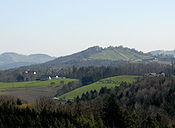
Log cabin
A log cabin is a house built from logs. It is a fairly simple type of log house. A distinction should be drawn between the traditional meanings of "log cabin" and "log house." Historically most "Log cabins" were a simple one- or 1½-story structures, somewhat impermanent, and less finished or less...
. The settlement at Zug
Zug
Zug , is a German-speaking city in Switzerland. The name ‘Zug’ originates from fishing vocabulary; in the Middle Ages it referred to the right to ‘pull up’ fishing nets and hence to the right to fish.The city of Zug is located in the Canton of Zug and is its capital...
, Switzerland, was destroyed by fire and gives important insights into the material culture and the settlement organisation of this period. It has yielded a number of dendro-dates as well.
Fortified settlements
Fortified hilltop settlements become common in the Urnfield period. Often a steep spur was used, where only part of the circumference had to be fortified. Depending on the locally available materials, dry-stone walls, gridded timbers filled with stones or soil or plank and palisade type pfostenschlitzmauerPfostenschlitzmauer
Pfostenschlitzmauer is a method of constructing defensive walls protecting Iron Age hillforts and oppida in Central Europe, including Bavaria and the Czech Republic. It is characterized by vertical wooden posts set into the front stone facing. The rampart is constructed from a timber lattice...
fortifications were used. Other fortified settlements utilise rivers-bends and swampy areas.
At the hill fort
Hill fort
A hill fort is a type of earthworks used as a fortified refuge or defended settlement, located to exploit a rise in elevation for defensive advantage. They are typically European and of the Bronze and Iron Ages. Some were used in the post-Roman period...
of Hořovice near Beroun (CR), 50 ha were surrounded by a stone wall. Most settlements are much smaller. Metal working is concentrated in the fortified settlements. On the Runde Berg near Urach, Germany, 25 stone moulds
Molding (process)
Molding or moulding is the process of manufacturing by shaping pliable raw material using a rigid frame or model called a pattern....
have been found.
Hillforts are interpreted as central places. Some scholars see the emergence of hill forts as a sign of increased warfare. Most hillforts were abandoned at the end of the Bronze Age.
As far as we know, there are no special dwellings for an upper class, but few settlements have been excavated to any extent. In the Franche-Comté
Franche-Comté
Franche-Comté the former "Free County" of Burgundy, as distinct from the neighbouring Duchy, is an administrative region and a traditional province of eastern France...
, caves were utilised for settlement, maybe in times of trouble.
Material culture
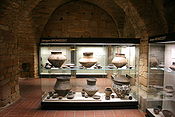

Pottery
The pottery is normally well made, with a smooth surface and a normally sharply carinated profile. Some forms are thought to imitate metal prototypes. Biconical pots with cylindrical necks are especially characteristic. There is some incised decoration, but a large part of the surface was normally left plain. Fluted decoration is common. In the Swiss pile dwellings, the incised decoration was sometimes inlaid with tin foilTin foil
Tin foil, also spelled tinfoil, is a thin foil made of tin. Actual tin foil was superseded by cheaper and more durable aluminium foil after World War II, and aluminium foil is sometimes confused with "tin foil" because of its similarity to the former material.-History:Foil made from a thin leaf of...
.
Pottery kilns
Kiln
A kiln is a thermally insulated chamber, or oven, in which a controlled temperature regime is produced. Uses include the hardening, burning or drying of materials...
were already known (Elchinger Kreuz, Bavaria), as is indicated by the homogeneous surface of the vessels as well.
Other vessels include cups of beaten sheet-bronze
Bronze
Bronze is a metal alloy consisting primarily of copper, usually with tin as the main additive. It is hard and brittle, and it was particularly significant in antiquity, so much so that the Bronze Age was named after the metal...
with riveted handles (type Jenišovice) and large cauldron
Cauldron
A cauldron or caldron is a large metal pot for cooking and/or boiling over an open fire, with a large mouth and frequently with an arc-shaped hanger.- Etymology :...
s with cross attachments. Wooden vessels have only been preserved in waterlogged contexts, for example from Auvernier (Neuchâtel), but may have been quite widespread.
Tools and weapons
Typical bronze tools include winged and socketed axeAxe
The axe, or ax, is an implement that has been used for millennia to shape, split and cut wood; to harvest timber; as a weapon; and as a ceremonial or heraldic symbol...
s. In the North, stone axes were still in use.
The leaf-shaped Urnfield sword
Sword
A sword is a bladed weapon used primarily for cutting or thrusting. The precise definition of the term varies with the historical epoch or the geographical region under consideration...
could be used for slashing, in contrast to the stabbing-swords of the preceding tumulus culture. It commonly possessed a ricasso
Ricasso
A ricasso is a part of sword and knife blades. It is the section just above the guard or handle. It is sometimes unsharpened and unbevelled.The first unsharpened ricassos were found on Middle Bronze Age swords...
. The hilt
Hilt
The hilt of a sword is its handle, consisting of a guard,grip and pommel. The guard may contain a crossguard or quillons. A ricasso may also be present, but this is rarely the case...
was normally made from bronze as well. It was cast separately and consisted of a different alloy. These solid hilted swords were known since Bronze D (Rixheim swords). Other swords have tanged blades and probably had a wood, bone, or antler hilt. Flange-hilted swords had organic inlays in the hilt. Swords include Auvernier, Kressborn-Hemigkofen, Erbenheim, Möhringen, Weltenburg, Hemigkofen and Tachlovice-types.
Protective gear like shield
Shield
A shield is a type of personal armor, meant to intercept attacks, either by stopping projectiles such as arrows or redirecting a hit from a sword, mace or battle axe to the side of the shield-bearer....
s, cuirass
Cuirass
A cuirass is a piece of armour, formed of a single or multiple pieces of metal or other rigid material, which covers the front of the torso...
es, greave
Greave
A greave is a piece of armour that protects the leg.-Description:...
s and helmet
Helmet
A helmet is a form of protective gear worn on the head to protect it from injuries.Ceremonial or symbolic helmets without protective function are sometimes used. The oldest known use of helmets was by Assyrian soldiers in 900BC, who wore thick leather or bronze helmets to protect the head from...
s are extremely rare and almost never found in burials. The best-known example of a bronze shield comes from Plzeň in Bohemia and has a riveted handhold. Comparable pieces have been found in Germany, Western Poland, Denmark, Great Britain and Ireland. They are supposed to have been made in upper Italy or the Eastern Alps
Eastern Alps
Eastern Alps is the name given to the eastern half of the Alps, usually defined as the area east of the Splügen Pass in eastern Switzerland. North of the Splügen Pass, the Posterior Rhine forms the border, and south of the pass, the Liro river and Lake Como form the boundary line.-Geography:The...
and imitate wooden shields. Irish bogs have yielded examples of leather shields (Clonbrinn, Co. Wexford). Bronze cuirasses are known since Bronze D (Čaka
Caka
Čaka is a village and municipality in the Levice District in the Nitra Region of south-west Slovakia.-Geography:The village lies at an altitude of 188 metres and covers an area of 9.069 km².It has a population of about 830 people.-Facilities:...
, grave II, Slovakia). Complete bronze cuirasses have been found in Saint Germain du Plain, nine examples, one inside the other, in Marmesse, Haute Marne (France), fragments in Albstadt-Pfeffingen (Germany). Bronze dishes (phalerae) may have been sewn on a leather armour. Greaves of richly decorated sheet-bronze are known from Kloštar Ivanić (Croatia) and the Paulus cave near Beuron
Beuron
Beuron is a municipality in the district of Sigmaringen in Baden-Württemberg in Germany. Beuron is known for the Beuron Archabbey and the Beuron Art School for religious art.Beuron is divided into subdistricts :* Hausen im Donautal* Langenbrunn* Neidingen...
(Germany).
Chariots
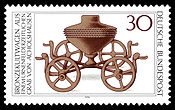
Wagon
A wagon is a heavy four-wheeled vehicle pulled by draught animals; it was formerly often called a wain, and if low and sideless may be called a dray, trolley or float....
-burials of four wheeled wagons with bronze fittings are known from the early Urnfield period. They include Hart an der Altz (Kr. Altötting), Mengen (Kr. Sigmaringen), Poing (Kr. Ebersberg), Königsbronn (Kr. Heidenheim) from Germany and St. Sulpice (Vaud
Vaud
Vaud is one of the 26 cantons of Switzerland and is located in Romandy, the French-speaking southwestern part of the country. The capital is Lausanne. The name of the Canton in Switzerland's other languages are Vaud in Italian , Waadt in German , and Vad in Romansh.-History:Along the lakes,...
), Switzerland. In Alz, the chariot had been placed on the pyre, pieces of bone are attached to the partially melted metal of the axles. Bronze (one-part) bits appear at the same time. Two-part horse bits are only known from late Urnfield contexts and may be due to eastern influence. Wood- and bronze spoked wheels are known from Stade
Stade
Stade is a city in Lower Saxony, Germany and part of the Hamburg Metropolitan Region . It is the seat of the district named after it...
(Germany), a wooden spoked wheel from Mercurago, Italy. Wooden dish-wheels have been excavated at Corcelettes, Switzerland and the Wasserburg-Buchau, Germany (diameter 80 cm).
In Milavče near Domažlice
Domažlice
Domažlice is a town in the Plzeň Region of the Czech Republic.Domažlice is also a Municipality with Extended Competence and a Municipality with Commissioned Local Authority within the same borders.-History:...
, Bohemia
Bohemia
Bohemia is a historical region in central Europe, occupying the western two-thirds of the traditional Czech Lands. It is located in the contemporary Czech Republic with its capital in Prague...
, a four-wheeled miniature bronze wagon bearing a large cauldron
Cauldron
A cauldron or caldron is a large metal pot for cooking and/or boiling over an open fire, with a large mouth and frequently with an arc-shaped hanger.- Etymology :...
(diameter 30 cm) contained a cremation. This exceptionally rich burial was covered by a barrow
Tumulus
A tumulus is a mound of earth and stones raised over a grave or graves. Tumuli are also known as barrows, burial mounds, Hügelgrab or kurgans, and can be found throughout much of the world. A tumulus composed largely or entirely of stones is usually referred to as a cairn...
. The wagon from Acholshausen (Bavaria) comes from a male burial.
Such wagons are known from the Nordic Bronze Age
Nordic Bronze Age
The Nordic Bronze Age is the name given by Oscar Montelius to a period and a Bronze Age culture in Scandinavian pre-history, c. 1700-500 BC, with sites that reached as far east as Estonia. Succeeding the Late Neolithic culture, its ethnic and linguistic affinities are unknown in the absence of...
as well. The wagon from Skallerup, Denmark, contained a cremation as well. At Pekatel (Kr. Schwerin) in Mecklenburg
Mecklenburg
Mecklenburg is a historical region in northern Germany comprising the western and larger part of the federal-state Mecklenburg-Vorpommern...
a cauldron-wagon and other rich grave goods accompanied an inhumation under a barrow (Montelius III/IV). Another example comes from Ystad
Ystad
Ystad is a "locality", or town, and the seat of Ystad Municipality, Skåne County, Sweden, with 17,286 inhabitants .Settlement dates back to the 11th century and the town has become a busy ferryport, local administrative centre and tourist attraction...
in Sweden. South-eastern European examples include Kanya in Hungary and Orăştie
Orastie
Orăștie is a city in Hunedoara County, south-western Transylvania, Romania.-History:7th–9th century – on the site of an old swamp , which today is the old center of town, it was a human settlement whose traces have been scattered into the X-th century by the construction of the first...
in Romania
Romania
Romania is a country located at the crossroads of Central and Southeastern Europe, on the Lower Danube, within and outside the Carpathian arch, bordering on the Black Sea...
. Clay miniature wagons, sometimes with waterfowl were known there since the middle Bronze Age (Dupljaja, Vojvodina, Serbia).
The Lusatian
Lusatian culture
The Lusatian culture existed in the later Bronze Age and early Iron Age in most of today's Poland, parts of Czech Republic and Slovakia, parts of eastern Germany and parts of Ukraine...
chariot from Burg (Brandenburg
Brandenburg
Brandenburg is one of the sixteen federal-states of Germany. It lies in the east of the country and is one of the new federal states that were re-created in 1990 upon the reunification of the former West Germany and East Germany. The capital is Potsdam...
, Germany) has three wheel
Wheel
A wheel is a device that allows heavy objects to be moved easily through rotating on an axle through its center, facilitating movement or transportation while supporting a load, or performing labor in machines. Common examples found in transport applications. A wheel, together with an axle,...
s on a single axle
Axle
An axle is a central shaft for a rotating wheel or gear. On wheeled vehicles, the axle may be fixed to the wheels, rotating with them, or fixed to its surroundings, with the wheels rotating around the axle. In the former case, bearings or bushings are provided at the mounting points where the axle...
, on which waterfowl perch. The grave of Gammertingen
Gammertingen
Gammertingen is a town in the district of Sigmaringen, in Baden-Württemberg, Germany. It is situated 18 km north of Sigmaringen....
(Kr. Sigmaringen, Germany) contained two socketed horned applications that probably belonged to a miniature wagon comparable to the Burg example, together with six miniature spoked wheels.
Hoards
HoardHoard
In archaeology, a hoard is a collection of valuable objects or artifacts, sometimes purposely buried in the ground. This would usually be with the intention of later recovery by the hoarder; hoarders sometimes died before retrieving the hoard, and these surviving hoards may be uncovered by...
s are very common in the Urnfield culture. The custom is abandoned at the end of the Bronze Age. They were often deposited in rivers and wet places like swamps. As these spots were often quite inaccessible, they most probably represent gifts to the gods. Other hoards contain either broken or miscast objects that were probably intended for reuse by bronze smiths. As Late Urnfield hoards often contain the same range of objects as earlier graves, some scholars interpret hoarding as a way to supply personal equipment for the hereafter. In the river Trieux, Côtes du Nord, complete swords were found together with numerous antlers of red deer that may have had a religious significance as well.
Iron
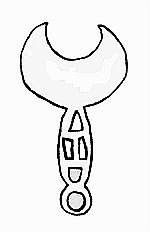
Plettenberg (mountain)
Plettenberg is a mountain of Baden-Württemberg, Germany. It is located in Zollernalbkreis....
, Germany) and pins. The use of iron
Iron
Iron is a chemical element with the symbol Fe and atomic number 26. It is a metal in the first transition series. It is the most common element forming the planet Earth as a whole, forming much of Earth's outer and inner core. It is the fourth most common element in the Earth's crust...
for weapons and domestic items in Europe only started in the following Hallstatt culture
Hallstatt culture
The Hallstatt culture was the predominant Central European culture from the 8th to 6th centuries BC , developing out of the Urnfield culture of the 12th century BC and followed in much of Central Europe by the La Tène culture.By the 6th century BC, the Hallstatt culture extended for some...
. The widespread use of iron for tools only occurred in the late Iron Age
Iron Age
The Iron Age is the archaeological period generally occurring after the Bronze Age, marked by the prevalent use of iron. The early period of the age is characterized by the widespread use of iron or steel. The adoption of such material coincided with other changes in society, including differing...
La Tène culture
La Tène culture
The La Tène culture was a European Iron Age culture named after the archaeological site of La Tène on the north side of Lake Neuchâtel in Switzerland, where a rich cache of artifacts was discovered by Hansli Kopp in 1857....
.
Economy
Cattle, pigs, sheep and goats were kept, as well as horses and dogs, and maybe geese. The cattleCattle
Cattle are the most common type of large domesticated ungulates. They are a prominent modern member of the subfamily Bovinae, are the most widespread species of the genus Bos, and are most commonly classified collectively as Bos primigenius...
were rather small, with a height of 1.20 m at the withers
Withers
The withers is the ridge between the shoulder blades of a four-legged animal. In many species it is the tallest point of the body, and in horses and dogs it is the standard place to measure the animal's height .-Horses:The withers in horses are formed by the dorsal spinal processes of roughly the...
. Horses were not much bigger with a mean of 1.25 m.
Forest clearance was intensive in the Urnfield period. Probably open meadows were created for the first time, as shown by pollen analysis
Pollen analysis
Analysis of the distribution of pollen grains of various species contained in surface layer deposits, especially peat bogs and lake sediments, from which a record of past climate may be inferred. Because the lake sediments accumulate over time, a core of the mud will show that the mud at the bottom...
. This led to increased erosion
Erosion
Erosion is when materials are removed from the surface and changed into something else. It only works by hydraulic actions and transport of solids in the natural environment, and leads to the deposition of these materials elsewhere...
and sediment-load of the rivers.
Wheat
Wheat
Wheat is a cereal grain, originally from the Levant region of the Near East, but now cultivated worldwide. In 2007 world production of wheat was 607 million tons, making it the third most-produced cereal after maize and rice...
and barley
Barley
Barley is a major cereal grain, a member of the grass family. It serves as a major animal fodder, as a base malt for beer and certain distilled beverages, and as a component of various health foods...
were cultivated, together with pulses and the horse bean. Poppy seed
Poppy seed
Poppy seed is an oilseed obtained from the opium poppy . The tiny kidney-shaped seeds have been harvested from dried seed pods by various civilizations for thousands of years...
s were used for oil or as a drug
Recreational drug use
Recreational drug use is the use of a drug, usually psychoactive, with the intention of creating or enhancing recreational experience. Such use is controversial, however, often being considered to be also drug abuse, and it is often illegal...
. Millet
Millet
The millets are a group of small-seeded species of cereal crops or grains, widely grown around the world for food and fodder. They do not form a taxonomic group, but rather a functional or agronomic one. Their essential similarities are that they are small-seeded grasses grown in difficult...
and oat
Oat
The common oat is a species of cereal grain grown for its seed, which is known by the same name . While oats are suitable for human consumption as oatmeal and rolled oats, one of the most common uses is as livestock feed...
s were cultivated for the first time in Hungary and Bohemia, rye
Rye
Rye is a grass grown extensively as a grain and as a forage crop. It is a member of the wheat tribe and is closely related to barley and wheat. Rye grain is used for flour, rye bread, rye beer, some whiskeys, some vodkas, and animal fodder...
was already cultivated, further west it was only a noxious weed. Flax
Flax
Flax is a member of the genus Linum in the family Linaceae. It is native to the region extending from the eastern Mediterranean to India and was probably first domesticated in the Fertile Crescent...
seems to have been of reduced importance, maybe because mainly wool
Wool
Wool is the textile fiber obtained from sheep and certain other animals, including cashmere from goats, mohair from goats, qiviut from muskoxen, vicuña, alpaca, camel from animals in the camel family, and angora from rabbits....
was used for clothes.
Hazel nuts, apples, pears, sloes and acorns were collected. Some rich graves contain bronze sieve
Sieve
A sieve, or sifter, separates wanted elements from unwanted material using a woven screen such as a mesh or net. However, in cooking, especially with flour, a sifter is used to aerate the substance, among other things. A strainer is a type of sieve typically used to separate a solid from a liquid...
s that have been interpreted as wine
Wine
Wine is an alcoholic beverage, made of fermented fruit juice, usually from grapes. The natural chemical balance of grapes lets them ferment without the addition of sugars, acids, enzymes, or other nutrients. Grape wine is produced by fermenting crushed grapes using various types of yeast. Yeast...
-sieves (Hart an der Alz). This beverage would have been imported from the South, but supporting evidence is lacking.
In the lacustrine
Lake
A lake is a body of relatively still fresh or salt water of considerable size, localized in a basin, that is surrounded by land. Lakes are inland and not part of the ocean and therefore are distinct from lagoons, and are larger and deeper than ponds. Lakes can be contrasted with rivers or streams,...
settlement of Zug, remains of a broth made of spelt
Spelt
Spelt is a hexaploid species of wheat. Spelt was an important staple in parts of Europe from the Bronze Age to medieval times; it now survives as a relict crop in Central Europe and northern Spain and has found a new market as a health food. Spelt is sometimes considered a subspecies of the...
and millet
Millet
The millets are a group of small-seeded species of cereal crops or grains, widely grown around the world for food and fodder. They do not form a taxonomic group, but rather a functional or agronomic one. Their essential similarities are that they are small-seeded grasses grown in difficult...
have been found. In the lower-Rhine urnfields, leavened bread
Bread
Bread is a staple food prepared by cooking a dough of flour and water and often additional ingredients. Doughs are usually baked, but in some cuisines breads are steamed , fried , or baked on an unoiled frying pan . It may be leavened or unleavened...
was often placed on the pyre and burnt fragments have thus been preserved.
Wool was spun (finds of spindle whorls
Spindle (textiles)
A spindle is a wooden spike used for spinning wool, flax, hemp, cotton, and other fibres into thread. It is commonly weighted at either the bottom middle or top, most commonly by a circular or spherical object called a whorl, and may also have a hook, groove or notch, though spindles without...
are common) and woven on the warp-weighted loom
Loom
A loom is a device used to weave cloth. The basic purpose of any loom is to hold the warp threads under tension to facilitate the interweaving of the weft threads...
, bronze needles (Unteruhldingen) were used for sewing
Sewing
Sewing is the craft of fastening or attaching objects using stitches made with a needle and thread. Sewing is one of the oldest of the textile arts, arising in the Paleolithic era...
.
There is some suggestion that the Urnfield culture too is associated with a wetter climatic period than the earlier Tumulus cultures. This may be associated with the diversion of the mid-latitude winter storms north of the Pyrenees and the Alps, possibly associated with drier conditions in the Mediterranean basin.
Graves
In the tumulus-period, multiple inhumations under barrows were common, at least for the upper levels of society. In the Urnfield period, inhumation and burial in single graves prevails, though some barrows exist.In the earliest phases of the Urnfield period, man-shaped graves were dug, sometimes provided with a stone lined floor, in which the cremated remains of the deceased were spread. Only later, burial in urns became prevalent. Some scholars speculate that this may have marked a fundamental shift in people's beliefs or myths about life and the afterlife.
The size of the urnfields is variable. In Bavaria, they can contain hundreds of burials, while the largest cemetery in Baden-Württemberg
Baden-Württemberg
Baden-Württemberg is one of the 16 states of Germany. Baden-Württemberg is in the southwestern part of the country to the east of the Upper Rhine, and is the third largest in both area and population of Germany's sixteen states, with an area of and 10.7 million inhabitants...
in Dautmergen
Dautmergen
Dautmergen is a municipality in the Zollernalbkreis district, in Baden-Württemberg, Germany....
has only 30 graves.
The dead were placed on pyre
Pyre
A pyre , also known as a funeral pyre, is a structure, usually made of wood, for burning a body as part of a funeral rite...
s, covered in their personal jewellery, which often shows traces of the fire and sometimes food-offerings. The cremated bone-remains are much larger than in the Roman period, which indicates that less wood was used. Often, the bones have been incompletely collected.
Most urnfields are abandoned with the end of the Bronze Age, only the Lower Rhine urnfields continue in use in the early Iron Age (Ha C, sometimes even D).
The cremated bones could be placed in simple pits. Sometimes the dense concentration of the bones indicates a container of organic material, sometimes the bones were simply shattered.
If the bones were placed in urns, these were often covered by a shallow bowl or a stone. In a special type of burial (bell-graves) the urns are completely covered by an inverted larger vessel. As graves rarely overlap, they may have been marked by wooden posts or stones.
Stone-pacing graves are typical of the Unstrut group.
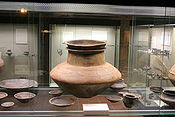
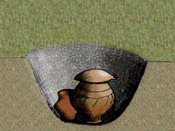
Grave gifts
The urn containing the cremated bones is often accompanied by other, smaller ceramic vessels, like bowls and cups. They may have contained food. The urn is often placed in the centre of the assemblage. Often, these vessels have not been placed on the pyre. Metal grave gifts include razors, weapons that often have been deliberately destroyed (bent or broken), bracelets, pendants and pins. Metal grave gifts become rarer towards the end of the Urnfield culture, while the number of hoards increase.Burnt animal bones are often found, they may have been placed on the pyre as food. The marten bones in the grave of Seddin may have belonged to a garment (pelt).
Amber
Amber
Amber is fossilized tree resin , which has been appreciated for its color and natural beauty since Neolithic times. Amber is used as an ingredient in perfumes, as a healing agent in folk medicine, and as jewelry. There are five classes of amber, defined on the basis of their chemical constituents...
or glass
Glass
Glass is an amorphous solid material. Glasses are typically brittle and optically transparent.The most familiar type of glass, used for centuries in windows and drinking vessels, is soda-lime glass, composed of about 75% silica plus Na2O, CaO, and several minor additives...
bead
Bead
A bead is a small, decorative object that is usually pierced for threading or stringing. Beads range in size from under to over in diameter. A pair of beads made from Nassarius sea snail shells, approximately 100,000 years old, are thought to be the earliest known examples of jewellery. Beadwork...
s (Pfahlbautönnchen) are luxury items.
Upper-class graves
Upper-class burials were placed in wooden chambers, rarely stone cistCist
A cist from ) is a small stone-built coffin-like box or ossuary used to hold the bodies of the dead. Examples can be found across Europe and in the Middle East....
s or chambers with a stone-paved floor and covered with a barrow
Tumulus
A tumulus is a mound of earth and stones raised over a grave or graves. Tumuli are also known as barrows, burial mounds, Hügelgrab or kurgans, and can be found throughout much of the world. A tumulus composed largely or entirely of stones is usually referred to as a cairn...
or cairn
Cairn
Cairn is a term used mainly in the English-speaking world for a man-made pile of stones. It comes from the or . Cairns are found all over the world in uplands, on moorland, on mountaintops, near waterways and on sea cliffs, and also in barren desert and tundra areas...
. The graves contain especially finely made pottery, animal bones, usually pork, sometimes gold rings or sheets, in exceptional cases miniature wagons.
Some of these rich burials contain the remains of more than one person. In this case, women and children are normally seen as sacrifices. Until more is known about the status distribution and the social structure of the late Bronze Age, this interpretation should be viewed with caution.
Towards the end of the Urnfield period, some bodies were burnt in situ and then covered by a barrow, reminiscent of the burial of Patroclus
Patroclus
In Greek mythology, as recorded in the Iliad by Homer, Patroclus, or Patroklos , was the son of Menoetius, grandson of Actor, King of Opus, and was Achilles' beloved comrade and brother-in-arms....
as described by Homer
Homer
In the Western classical tradition Homer , is the author of the Iliad and the Odyssey, and is revered as the greatest ancient Greek epic poet. These epics lie at the beginning of the Western canon of literature, and have had an enormous influence on the history of literature.When he lived is...
and the burial of Beowulf
Beowulf
Beowulf , but modern scholars agree in naming it after the hero whose life is its subject." of an Old English heroic epic poem consisting of 3182 alliterative long lines, set in Scandinavia, commonly cited as one of the most important works of Anglo-Saxon literature.It survives in a single...
(with the additional ship burial
Ship burial
A ship burial or boat grave is a burial in which a ship or boat is used either as a container for the dead and the grave goods, or as a part of the grave goods itself. If the ship is very small, it is called a boat grave...
element). In the early Iron Age, inhumation became the rule again.
Cult
The KyffhäuserKyffhäuser
The Kyffhäuser is a range of hills located on the border of the German state of Thuringia with Saxony-Anhalt. It stands on the southern edge of the Harz. The range has a length of and a width of . It reaches its highest point at the Kulpenberg , situated in Thuringia...
caves in Thuringia
Thuringia
The Free State of Thuringia is a state of Germany, located in the central part of the country.It has an area of and 2.29 million inhabitants, making it the sixth smallest by area and the fifth smallest by population of Germany's sixteen states....
contain headless skeletons and split human and animal bones that have been interpreted as sacrifices. Other deposits include grain, knotted vegetable fibres and hair and bronze objects (axes, pendants and pins). The Ith
Ith
The Ith is a ridge in Germany's Central Uplands which is up to high. It lies about 40 km southwest of Hanover and, at 22 kilometres, is the longest line of crags in North Germany.- Geography :- Location :...
-caves (Lower Saxony
Lower Saxony
Lower Saxony is a German state situated in north-western Germany and is second in area and fourth in population among the sixteen states of Germany...
) have yielded comparative material.
In the Knovíz-culture, human bones with cut-marks and traces of burning have been found in settlement pits. They have been interpreted as evidence for cannibalism
Cannibalism
Cannibalism is the act or practice of humans eating the flesh of other human beings. It is also called anthropophagy...
. As these bones form a large part of the burials known this may have been a quite regular treatment including the ritual manipulation and dismemberment of human corpses.
Moon-shaped clay fire dog
Fire dog
A fire dog is a device of metal or ceramic intended to hold logs above the hearth , or to hold skewers above the fire for cooking....
s are thought to have a religious significance, as well as crescent shaped razors.
An obsession with waterbirds is indicated by numerous pictures and three-dimensional representations. Combined with the hoards deposited in rivers and swamps, it indicates religious beliefs connected with water. This has led some scholars to believe in serious droughts during the late Bronze Age.
Sometimes the water-birds are combined with circles, the so called sun-barque-motif.

